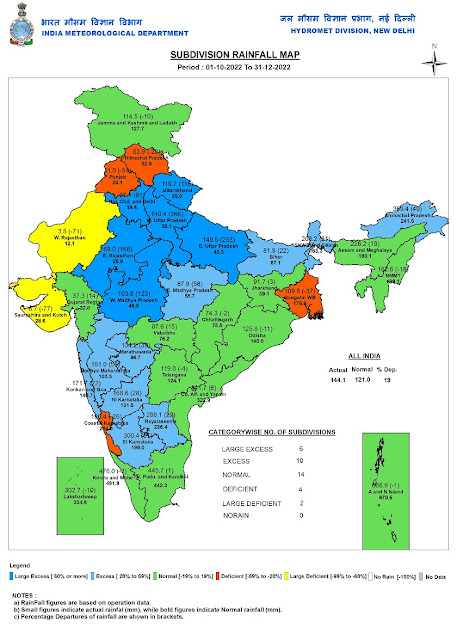Observed climate of India: Post-monsoon season | Northeast monsoon season | October - December 2022
As the year 2022 has come to an end, a season from October to December, known as the post-monsoon season for India or the northeast monsoon season over south-peninsula India, also have come to an end.
South Peninsular India, consisting of five meteorological subdivisions (Tamil Nadu, Coastal Andhra Pradesh, Rayalaseema, Kerala, and South Interior Karnataka), receives about 30% of its annual rainfall during the Northeast monsoon season. The re-establishment of northeasterly trade-wind regime associated with the southward movement of the Inter Tropical Convergence Zone (ITCZ) ushers-in the northeast monsoon, bringing much needed rainfall to the southern parts of India. However, the predictability of northeast monsoon is limited to some extent due to the strong day to day atmospheric variability caused by the passage of the synoptic scale weather systems such as easterly waves, lows, depressions, cyclones etc. The seasonal predictability of the northeast monsoon over the region is also influenced by the Madden Julian Oscillation (MJO), which represent the major global scale intra-seasonal variability pattern and the slowly varying boundary forcing like sea surface temperatures like ENSO and IOD.
The spatial rainfall distribution over India and all the meteorological subdivisions is given in Figure 1 and Figure 2 respectively. The rainfall statistics (actual observed, climatology and anomaly) for each homogeneous zones and All India is given in Figure 2. It was seen that the all-India seasonal rainfall was 19% above normal whereas rainfall over south peninsula was 9% above normal. The all India above normal rainfall is mainly coming in the month of October due to late withdrawal of Southwest monsoon. The southwest monsoon completely withdrew from the country on 23 October (against the normal date 15 October) and the northeast monsoon commenced over peninsula India on 29 October, which contributed to good rainfall activity over India in the month of October (Figure 4). The peninsula India as well as all India received deficient rainfall in the month of November. However, the rainfall peaked up again in the month of December (Figure 5) mainly over peninsula India associated with the cyclonic storm Mandous (6 - 12 December 2022) which crossed Tamil Nadu coast on 10 December (Fig 6).
As per the figure 5, there were two rainfall peaks (around 12 November and 12 December) and during that time MJO was over Indian Ocean and Maritime continent although they are with weak intensity (Figure 7). The MJO was very active most of the time over the maritime continent and western Pacific during this season. However, MJO was weak over Indian Ocean throughout the season.
During this season (Oct -Dec 2022) the La Niña conditions were prevailing over the Pacific Ocean (Fig. 8). The negative Indian Ocean Dipole prevailing over the Indian Ocean during June - September, turned to neutral in the month of November and continued the same in December (Fig. 8).
Figure 1: Observed (left), climatology (middle), and anomaly (right) of rainfall over India for the October-December 2022 (Climatology and anomaly based on 1971 to 2020 period). *Based on Realtime Data [Source: IMD]
Figure 2: Meteorological subdivision-wise rainfall distribution for the post-monsoon season/northeast monsoon season during October-December 2022. [Source: IMD]
Figure 3: Rainfall statistics (All India and four homogeneous regions) for the post-monsoon season/northeast monsoon season during October-December 2022. [Source: IMD]
Figure 5: Daily rainfall time-series for South Peninsula India from 1 October to 31 December 2022. [Source: IMD]
Figure 6: Tracks of cyclonic storms formed during October - December 2022. The tracks only with the intensity of depression and above are plotted [Source: IMD]

Figure 7: MJO phase diagram from 2 October to 30 December 2022. [Source: http://www.bom.gov.au/climate/mjo/]
Figure 8: Sea surface temperature (SST) anomaly (C) from October to December 2022. [SST data: NOAA ERSSTv5]
References:
https://www.imdpune.gov.in/nemonsoon22.php
https://www.satyabanbratna.com/










Comments
Post a Comment